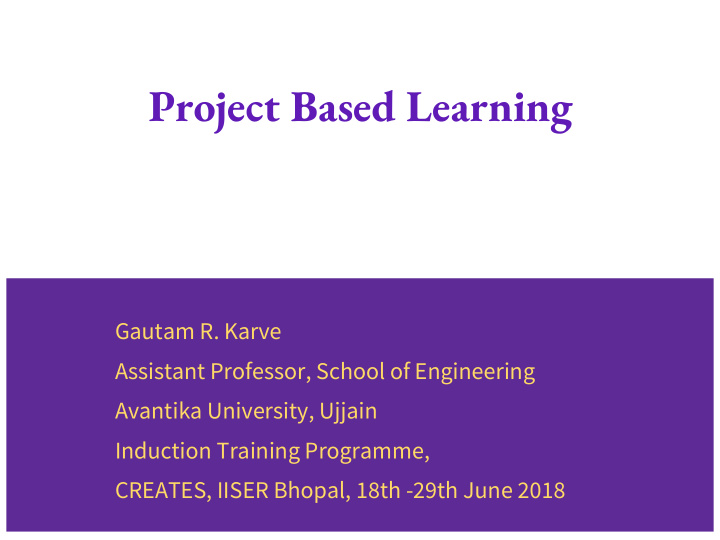



Project Based Learning Gautam R. Karve Assistant Professor, School of Engineering Avantika University, Ujjain Induction Training Programme, CREATES, IISER Bhopal, 18th -29th June 2018
What does Project Based Learning (PBL) look like? • (Ref: http://www.shsu.edu/centers/project-based-learning/examples.html ) • Wing Project: https://www.youtube.com/watch?v=HW7eq155QJE https://www.youtube.com/watch?v=iSmkjhCLgEw https://youtu.be/iSmkjhCLgEw
Five main Features of PBL • Start with Driving Questions/Problem to be solved • Situated Inquiry/ Real world application • Collaborations • Using Technology tools to support learning • Creating Artifacts Ref: Krajcik and Blumenfeld, Chap. 19, The Cambridge Handbook of the Learning Sciences. New York: Cambridge University Press.
Extract from the book: The Cambridge Handbook of the Learning Sciences Learning Environments that are project based have five key features (Blumenfeld et al. 1991; Krajcik, et al., 1994, Krajcik, Czerniak, & Berger, 2002): 1. They start with a driving question, a problem to be solved. 2. Students explore the driving question by participating in authentic, situated inquiry- processes of problem solving that are central to expert performance in the discipline. As students explore the driving question, they learn and apply important ideas in the discipline. 3. Students, teachers and community members engage in collaborative activities to find solutions to the driving question. This mirrors the complex social situation of expert problem solving. 4. While engaged in inquiry process, students are scaffolded with learning technologies that help them participate in activities normally beyond their ability. 5. Students create a set of tangible products that address the driving question. These are shared artifacts, publicly accessible external representations of the class’s learning.
PBL is working in our Induction Training Programme participant presentations too • Driving questions: Understanding of these emerging learning tools will help our Univ. • Our projects have a real world connect: Presentations available for anyone • We are collaborating: Presentation exercise • Creating Artifacts: Our PPT slides and our presentation is an artifact
Some Universities using PBL • Olin College of Engineering • Sam Houston State University • Buck Institute for Education And many more …
PBL creates Artifacts and Answers Questions Understanding Microbial Self-defense Armor for Full-force Impact, Community Dynamics and Function Scenario-based Self-Defense Training Ref: http://www.olin.edu/research-impact/sample-projects/
PBL for Our Universities • Better suited for Engineering Education • May not be suitable for all subjects • Existing Faculty/Management need to be oriented • Homework on part of teacher required
Other Resources https://en.wikipedia.org/wiki/Project-based_learning https://www.intel.com/content/www/us/en/education/k12/teach-elements.html https://www.edutopia.org/project-based-learning Sawyer, R. K. (2006) The Cambridge Handbook of the Learning Sciences. New York: Cambridge University Press. https://www.youtube.com/embed/HrXNjVkp-wU?autoplay=1
Thank you
Recommend
More recommend